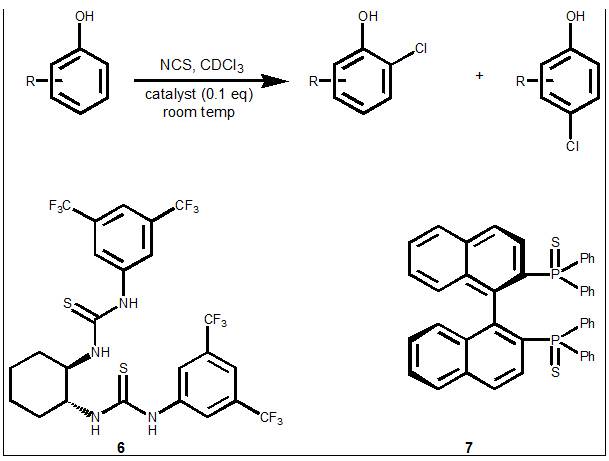Phenolics like cresols methylated phenols. Polycarbonate is incompatible with strong alkaline solutions and is soluble in chlorinated hydrocarbons.

Highly Regioselective Ortho Chlorination Of Phenol With Sulfuryl Chloride In The Presence Of Amines Sciencedirect
A wide variety of solvents like dichloromethane DCM pure or mixed with acetone or hexane and acetonehexane mixtures can be used.

What are chlorinated phenols used for. Among them alkaline chemicals alcohols and high-temperature phenols break the carbonate linkage of a macromolecular chain which causes a reduction in molecular weight. It has been used for a wide range of samples like soils sediments and animal and plant tissues. And polychlorinated biphenyls PCBs once widely used in electrical transformers and capacitors.
Most commonly produced by marine organisms that utilize the chloride and bromide in ocean waters. 181 C Matrix Scientific 098829. They are commonly but inaccurately referred to as dioxins for simplicity because every PCDD molecule contains a dibenzo-14-dioxin skeletal structure with 14-dioxin as the central ringMembers of the PCDD family bioaccumulate in humans.
2623 C Biosynth J-610001. Chloramines are relatively stable releasing chlorine over long periods time. Use of allelopathic interactions to favor the crop and reduce weed infestation has been used for centuries without understanding the chemical basis of the phenomenon.
Most phenols are weak acids pK a 10 and do not react with sodium bicarbonate which is a weak base itself pK a H 2 CO 3637 103. Allelochemicals are chemically diverse eg terpenes alkaloids and non. Examples include chlorinated benzenes used as solvents and pesticides.
358-360 F 760 mmHg 1811111-1822222 C. Derivatives of tyrosine tryptophan and various pyrrole derivatives. Formation of halogenated by-products of parabens in chlorinated water.
Graphite furnace and flame atomic absorption spectrophotometry GFAA and FLAA anodic stripping voltammetry ASV cold-vapor technique atomic fluorescence. Soxhlet extraction is a simple and effective method. De Boer in Encyclopedia of Analytical Science Second Edition 2005 Soxhlet Extraction.
One type of stabilizer that protects against light degradation is a UV screener called hydroxybenzotriazole. 25 C 902 mmHg 867683 C 760 mmHg FooDB FDB000893 182 C Parchem fine specialty chemicals 57245. The 7000 series contains analytical and guidance methods used to determine the presence of inorganic analytes including arsenic antimony chromium mercury white phosphorus and selenium by the following technologies.
People may be exposed to PCP in occupational settings through the inhalation of contaminated workplace air and dermal contact or with wood products treated with PCP. As herbicide options dwindle in the era of herbicide-resistant weeds there is renewed interest in utilization of allelopathy for weed management. Moreover it is insoluble in aliphatic hydrocarbons.
What is the Difference. In addition aromatic hydrocarbons such as benzene toluene and xylene and chlorinated hydrocarbons such as methylene chloride and chloroform swell or dissolve PC resin. This difference in acidity can be exploited to separate carboxylic acids and phenols from each other in an organic layer.
Monochloroamine one of the chloramines is derived. The addition of small amounts of polyhydric phenols can enhance the melt strength flame retardance and other properties. For example phenols and anilines react quickly with chlorine and bromine water to give multiple halogenated products.
Environ Health Perspect 117 4639644. Chlorinated and brominated aromatic compounds are also numerous eg. The primary advantages of enzyme detergents are that they are more environmentally friendly and often.
Enzyme-based detergents which are amended with enzymes such as amylases and other carbohydrate-degrading enzymes proteases and lipases are finding acceptance in specialized food industry applications. Chloramines are derivatives of ammonia by substitution of one two or all three hydrogen atoms with chlorine atoms. However they do react with a strong base like NaOH.
The main contaminants include other polychlorinated phenols polychlorinated dibenzo-p-dioxins and polychlorinated dibenzo furans. Overall however the presence of halogen. Another class of chlorinated compounds called chloramines are widely used as disinfectants.
This substance in pain production in form of solvents such as aromatic hydrocarbons alcohols ketones and esters solvent-borne paints or as dispersions in water water-borne paints as true emulsions. Exposure to bisphenol A and other phenols in neonatal intensive care unit premature infants. An example of some of these chemicals include Chlorinated phenols tribromphenol chlorinated paraffins dimethylfumarate etc which are used to preserve the materials such.
To protect against oxidation reactions antioxidants are used. Pentachlorophenol used in fungicides and herbicides. While many phenols dissolve poorly in water 83 g100 mL at 20.
Both general-purpose and specialty grades polycarbonates are present in the market. Compounds which inhibit. Next chemicals used in the manufacturing process also contribute to the negative impact that shoes have on the environment.
Calafat AM Weuve J Ye X Jia LT Hu H Ringer S et al. Various antioxidants are available such as monomeric and polymeric hindered phenols. 181 C Alfa Aesar 33213 44526 A15760.
Canosa P Rodriguez I Rubi E Negreira N Cela R. Many chemical adhesives and tanning chemicals are used to process different parts of the shoe. 181 C Alfa Aesar.
Short-term exposure to large amounts of PCP can cause harmful effects on the liver. Some of these naturally. The epoxy polymers are made from 1-Chloro-23-epoxypropane and substituted phenols such as bisphenol A.
The aromatic benzene nucleus is susceptible to aerobic and anaerobic metabolism although the latter occurs relatively slowly. For this reason stabilizers are added to protect the polymer. In addition they are not normally used in topcoats for outdoors.
Polychlorinated dibenzodioxins PCDDs or simply dioxins are a group of polyhalogenated organic compounds that are significant environmental pollutants. 359 F 1816667 C NIOSH SJ3325000 182 C Food and Agriculture Organization of the United Nations Phenol. Chlorinated detergents are most often used to clean protein residues.